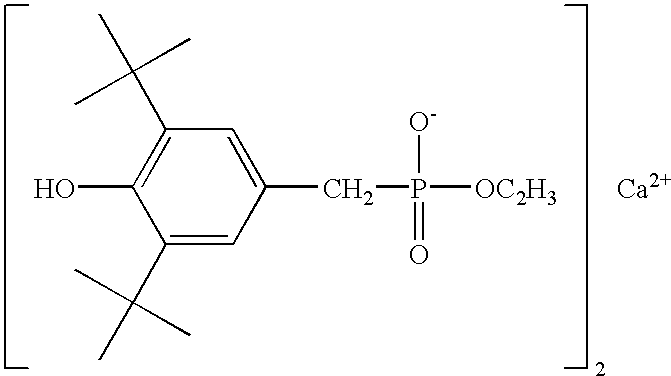1. U.S. Pat. No. 5,182,359, EP-A-0532943, JP-A-5-125165 / 1993 disclose process for producing polyesters suitable for extrusion
processing, which comprises adding, on reacting a
dicarboxylic acid component or ester-forming derivatives thereof with a
diol component containing 2 to 8 carbon atoms, an
ethylene oxide adduct of
bisphenol A. However, polyesters obtained by the process gives extrusion blow molded articles having insufficient
melt viscosity, severe drawdown on melt parisions and failure in molding articles under a
stable state; further,
surface roughness occurs when molded at a low temperature.
2. U.S. Pat. Nos. 4,161,579, 4,219,527, 4,234,708 disclose process for producing
polyester suitable for extrusion blow molding, which comprises adding, on reacting
terephthalic acid with
ethylene glycol, a crosslinking agent such as trimethylol
propane, or
pentaerythritol or
trimellitic acid, and further adding a chain terminating agent such as
benzoic acid or
stearic acid. However, crosslinking agent and chain terminating agent employed in the process improve the
melt viscosity, but cause quicker
crystallization rate as compared with the unmodified
polyester, and
crystallization whitening occurs on producing shaped articles in larger length. Furthermore, shaped articles produced from said copolyester also exhibits
surface roughness as described in above process 1.
4. U.S. Pat. No. 4,554,329 discloses a process for producing copolyester suitable for extrusion blow molding, which comprises reacting terephthalic acid,
isophthalic acid and
ethylene glycol, adding a crosslinking agent such as
pentaerythritol, and further adding m-anisic acid. Adding pentaerythritol and m-anisic acid in the process can lead to a sufficient high degree of
melt viscosity and rather less gel generation, and adding
isophthalic acid can suppress the
crystallization rate. However, the slight surface roughness and crystallization whitening still occur on producing shaped articles having a length of at least 30 cm.
5. U.S. Pat. Nos. 3,558,557, 4,188,357, 4,196,275 disclose a process for producing copolyester suitable for extrusion blow molding, which comprises reacting terephthalic acid,
ethylene glycol and disphenol A diglycol
ether with small amount of multifunctional groups crosslinking agent. However, in this method, the
bisphenol A structural modification agent uesd causes non-
crystal phase, therefore increase of molecular weight only depends on melt phase
polymerization, thus leading to insufficient high degree of melt
viscosity and severe drawdown of melted parisons on producing shaped articles. In order to solve the problem, several methods are proposed which comprise adding substantially disphenol A diglycol
ether, which causes extremely long period of time experienced by the polyester subjecting to melt phase polymerization, therefore leading to heat splitting, yellowish color of polyester and failure in proper control to the melt
viscosity.
6. EP 0774 477A2 discloses a process for producing copolyester, which comprises adding, on reacting terephthalic acid with ethylene glycol, 1 to 4 mole % of aliphatic or alicyclic
bifunctional group component (called a1 unit, such as
cyclohexane dimethanol and
cyclohexane dicarboxylic acid) or 0.5 to 7 mole % of aromatic
diol component (called a2 unit, such as 2,2-bis (4-(2-hydroxyethoxyl)phenyl)propane and 1,4-bis(2- hydroxyethoxyl)
benzene) or aromatic
dicarboxylic acid component (called a3 unit, such as
naphthalene dicarboxylicacid and 4,4-diphenyldicarboxylic acid), and reacting one of above compounds with 0.005 to 1 mole % of compound containing at least trifunctional group (called b1 unit, such as
trimethylolpropane,
trimellitic anhydride and pentaerythritol), and further reacting with a monofunctional group compound in a specific amount (called c unit, such as
benzoic acid,
naphthoic acid, trialkoxyphenyl acid,
stearic acid, m-anisic acid). Or, adding, on reacting terephthalic acid with ethylene glycol, 0.5 to 7 mole % of
bifunctional group compound (called a2 unit, such as 2,2-bis (4-(2-hydroxyethoxyl)phenyl)propane and 1,4-bis(2- hydroxyethoxyl)
benzene) and 0.005 to 1 mole % of compound containing at least trifunctional group (called b2 unit, such as
trimethylolpropane,
trimellitic anhydride and pentaerythritol) to obtain another type of copolyester with specific
intrinsic viscosity. Further or, adding, on reacting terephthalic acid with ethylene glycol, 0.5 to 7 mole % of
bifunctional group compound (called a3 unit, such as
naphthalene dicarboxylicacid and 4,4-diphenyldicarboxylic acid) and 0.005 to 0.5 mole % of compound containing at least trifunctional group (called b1 unit, such as
trimethylolpropane, trimellitic anhydride and pentaerythritol) to obtain the other type of copolyester. The above described copolyesters are claimed to be suitable for extrusion blow molding processing.
7. Taiwan Patent No. 307780 discloses a copolyester which comprised adding, on reacting terephthalic acid with ethylene glycol, a
triol component such as 2-(4-(2-hydroxyethoxyl ) phenyl )-2-(3'-(2-hydroxyethyl-)-4'-(2-hydroxyethyl) phenyl) propane and / or 1,4-bis(2-hydroxyethoxyl)-2-(-2-hydroxyethyl)
benzene, in an amount of 0.01 to 1 mol % of the sum of diol component and
triol component. The copolyester also can be extrusion blow molded.
However, practice has proven severe drawdawn of melt parsions still occurs.
However, the copolyester, when produced commercially, is limited by the
prepolymer produced therefrom, which has a insufficient
reaction rate during
solid phase polymerization, needing a long period of time to reach sufficient high degree of
intrinsic viscosity; in particular, when the intrinsic
viscosity is over 1.0 dl / g, it's necessary to decrease the
throughput of solid phase polymerization, leading to production cost increased; further, due to long
retention time in solid phase polymerization tank, the copolyester
chip exhibit yellowish color therefore the molded articles produced therefrom exhibit undesirable yellowish color.
 Login to View More
Login to View More 


